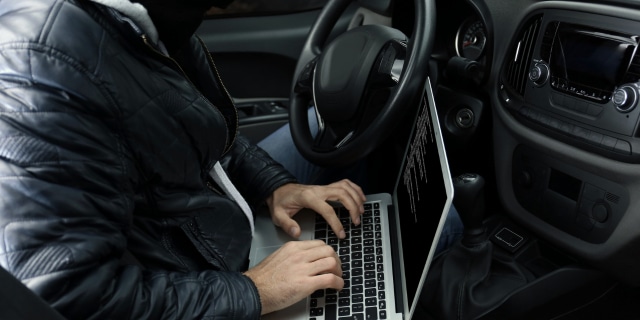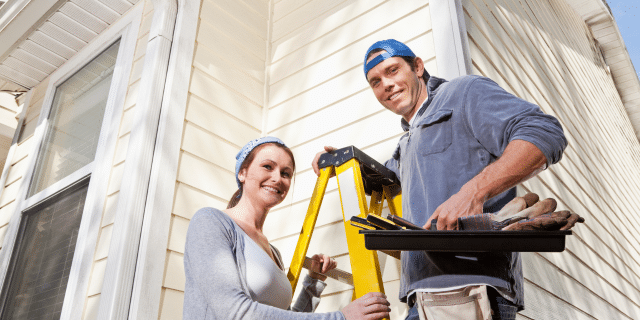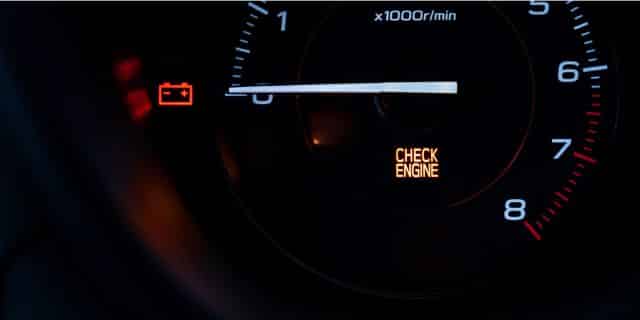
by California Casualty | Auto Insurance Info, Homeowners Insurance Info |
Your garage is more than just a place to park your car. It’s a space brimming with potential—whether as a storage haven, a home gym, or even a workspace. But if it’s cluttered, outdated, or simply an afterthought, it might not be adding as much value to your home as it could. Here’s how a few strategic updates can make all the difference.
The First Step: Take a Hard Look at Your Garage
Before you start transforming your garage, take a step back and assess its current state. Is it simply a parking space, or do you use it for storage, projects, or workouts? Look for structural issues—cracks in the foundation, roof leaks, signs of critters or water damage. Understanding what you have (and what you need) will help you prioritize the best upgrades. Make sure to address any issues before you take the next step.
Upgrade Your Garage Door—Form Meets Function
Your garage door plays a big role in both security and curb appeal. If it’s outdated or difficult to operate, consider replacing it with an insulated, easy-to-use model. Automatic doors add convenience, while lightweight aluminum doors are a sleek, modern option. Choosing a color that complements your home’s exterior can elevate your property’s appearance instantly.
Climate Control: Stay Comfortable Year-Round
Extreme temperatures can make your garage unbearable. Insulating the walls and ceiling can help protect your car and stored belongings while making the space more usable. Weatherstripping the garage door reduces drafts, while a properly vented space keeps carbon monoxide from seeping into your home. Depending on your budget, options range from simple portable heaters and fans to a fully integrated HVAC system.
Garages tend to accumulate everything from holiday decorations to sports gear. A well-organized space makes life easier and more appealing to future buyers. Invest in heavy-duty plastic bins, labeled and neatly stacked on secured shelving. Pegboards are a great way to hang tools, while overhead storage is perfect for seasonal items, luggage, and bulky equipment. Keeping things off the floor not only maximizes space but also prevents damage from spills or moisture.
Let There Be Light!
A dimly lit garage feels uninviting and unsafe. Install bright, energy-efficient LED lighting to make the space more functional. Motion-sensor lights outside improve security, while decorative sconces add a polished touch. If your budget allows, consider skylights or additional windows to brighten the space.
Durable & Stylish Flooring Options
Your garage floor takes a beating, so upgrading it can enhance durability and aesthetics. Epoxy coatings seal porous concrete, making cleanup easier and preventing stains. If you prefer a high-end look, polished concrete provides a sleek finish. Interlocking tiles in rubber, plastic, or vinyl offer cushioning and are easy to install, while rollout mats provide simple protection against stains. For cold climates, radiant heating under the floor can add comfort and melt snow from your car.
Power Up: Add More Electrical Outlets
A well-wired garage is essential for both convenience and safety. Installing multiple GFCI-protected outlets ensures you have enough power for tools, appliances, and even an electric vehicle charger. If you frequently work in the garage, proper wiring will prevent overload issues and enhance usability.
Plumbing for Extra Functionality
Adding plumbing can transform your garage into a more functional space. A utility sink makes cleanup easier, while a mudroom or pet-washing station can be a game-changer for active households. If you’re considering a larger renovation, incorporating plumbing could even allow for a future guest suite or apartment above the garage.
Keep It a Garage—But Make It Shine
While it may be tempting to turn your garage into a game room or art studio, think twice before eliminating its primary function. Most buyers want a place to park their car, and repurposing the garage completely can hurt resale value. However, if you’re considering adding a finished living space above the garage, that can be a big selling point—especially if it includes a kitchen and bathroom. Just be sure to check local zoning laws and secure the necessary permits before starting construction.
Your garage is a major focal point of your home’s exterior, so make sure it looks the part. If the outside appears worn or outdated, it can negatively impact your home’s perceived value. Consider upgrading the garage door with a stylish design like a carriage house or modern paneling. Fresh paint, decorative hardware, and window boxes can also make a significant impact without a hefty price tag.
Security & Safety: Protect What Matters
Since garages often provide direct access to the home, security is crucial. Installing a security system with cameras and motion detectors can deter potential intruders. Smart locks and keypad entry systems enhance protection while adding convenience. Inside the garage, be sure to have a fire extinguisher, smoke and carbon monoxide detectors, and a first aid kit. Regularly inspect for hazards like exposed wires or leaks and address them promptly.
With the right upgrades, your garage can be more than just a place to park—it can enhance your lifestyle, increase your home’s value, and even improve safety and security. Whether you’re planning small improvements or a major transformation, investing in your garage is an investment in your home’s future.
This article is furnished by California Casualty, providing auto and home insurance to educators, law enforcement officers, firefighters, and nurses. Get a quote at 1.866.704.8614 or www.calcas.com.

by California Casualty | Auto Insurance Info |
You love your car’s technology—keyless entry, GPS navigation, smartphone connectivity, and even self-driving features. But while these make driving easier, they also open the door to cyber threats. Just like your computer or phone, your car can be hacked, putting your personal data and even your safety at risk. So how can you stay one step ahead of cybercriminals? Here’s what you need to know to keep your car’s technology secure.
Understanding Your Car’s Vulnerabilities
One of the main entry points for cyber-attacks is the car’s infotainment or navigation system, which connects to the internet and often stores personal data such as contacts, locations, and music preferences. Additionally, many newer vehicles come equipped with Wi-Fi hotspots, allowing multiple devices to connect. While convenient, these features can also be exploited if not properly secured. To reduce risk, limit connections to trusted devices only and review your list of connected devices regularly. Be cautious when using third-party apps and services for navigation, entertainment, or remote control, as they can introduce vulnerabilities.
Beyond infotainment, various vehicle systems are also connected to the internet, including mileage tracking, tire pressure monitoring, fuel usage, braking data, and engine diagnostics. While this connectivity is helpful, it can also be a target for hackers. Check with your car dealer about the cybersecurity measures in place to protect your vehicle’s systems.
Protecting Your Key Fob
Your key fob, which grants access to your car, can be an easy target for hackers. Criminals use electronic signal amplifiers to intercept your fob’s signal, sometimes from up to 100 feet away, potentially unlocking and even starting your car without your knowledge. To prevent this:
- Store your key fob in a metal box or an RFID-blocking pouch to prevent signal interception.
- Some key fobs allow you to disable the wireless signal manually—check your vehicle manual to see if this feature is available.
- Wrapping your fob in aluminum foil can also help block signals in a pinch.
- Manually locking your doors is an extra safeguard, as some thieves use signal jammers to make you think your car is locked when it isn’t.
Keep Your Car’s Software Up to Date
Software updates are crucial for fixing security vulnerabilities. Cybercriminals often exploit outdated software to gain access to a vehicle’s systems. To protect yourself:
- Bring your car to the dealer for routine software updates.
- Check your manufacturer’s official website for downloadable updates.
- Stay in contact with your car manufacturer to receive notifications about recalls.
- Check gov for any relevant recalls affecting your vehicle.
Be Wary of Mechanics and Counterfeit Parts
Your mechanic has access to your car’s onboard diagnostics, which contain valuable data. While most mechanics are trustworthy, some may use this access to replicate keys and steal vehicles. Additionally, counterfeit parts pose not only cybersecurity risks but also physical safety concerns. Always ensure that you’re getting certified parts and working with reputable mechanics.
Be Cautious with Your OBD-II Port
The OBD-II port is a diagnostic access point that allows mechanics to check engine performance and retrieve vehicle data. However, leaving devices plugged into this port, such as insurance tracking devices, can make your car more vulnerable to cyberattacks. If you don’t need a device plugged in, remove it to reduce risk.
Extra Layers of Security
You can take simple steps to make it harder for a hacker to access your vehicle.
- Invest in a steering wheel lock. Even if a hacker gains electronic access to your car, they won’t be able to drive away with a physical lock in place.
- Turn off Bluetooth when not in use. If you’re not actively using Bluetooth, disable it to prevent hackers from getting to your phone or vehicle data.
- Secure your Wi-Fi password. If your car has Wi-Fi-enabled remote features, change the default password and enable two-factor authentication if possible. Never leave your password written down in your car and make sure to regularly update it.
- Disable remote systems when not needed. Features that allow remote unlocking, starting, or tracking should be turned off when not in use to minimize potential entry points for hackers.
Avoid Phishing Scams
Cybercriminals often use phishing tactics to gain access to vehicles. They may send fake emails with malicious links or attachments that install malware on your car’s system. Since cars lack built-in malware protection, these infections can be hard to detect. Protect yourself by:
- Never opening emails from unknown sources.
- Avoiding clicking on suspicious links.
- Verifying messages from your car manufacturer before taking any action.
Watch for Suspicious Activity
If you notice unusual behavior in your vehicle, such as unexpected setting changes, new sounds, or erratic electronic functions, it could be a sign of hacking. If anything seems off, contact your dealer or manufacturer immediately to investigate potential breaches.
By staying vigilant and following these cybersecurity measures, you can enjoy your car’s advanced technology while keeping it safe from hackers.
Finally, protect your vehicle with the right insurance for added peace of mind. Safe travels from all of us at California Casualty.
This article is furnished by California Casualty, providing auto and home insurance to educators, law enforcement officers, firefighters, and nurses. Get a quote at 1.866.704.8614 or www.calcas.com.

by California Casualty | Helpful Tips, Homeowners Insurance Info |
Imagine catching a leaky roof before it becomes a flood or spotting a crack in the foundation before it threatens your home’s stability. A yearly home maintenance inspection empowers you to identify small issues early, saving you time, money, and headaches. With a simple checklist and a little effort, you can keep your home in tip-top shape and avoid costly surprises down the road. Use this list as your guide to stay ahead of potential problems.
Gather Your Supplies
- Binoculars (for roof inspection)
- Flashlight (for inspecting dimly lit spaces)
- Ladder (to reach roofs, gutters, and higher areas)
- Electrical tester (to check outlets and circuits; ask your local hardware store for guidance)
- Moisture meter (to detect hidden dampness)
- Screwdriver set (for tightening fixtures and covers)
- Smartphone or camera (to document areas of concern)
- Notepad and pen (for notetaking and listing repairs that need to be made)
- Conduct a visual inspection of your roof from the ground with binoculars. If necessary, climb the ladder to get a closer look.
- Look for missing or damaged shingles, rusted or damaged flashing around vents, chimneys, or skylights.
- Check for signs of moss or algae and debris accumulation.
- Clear any debris from clogged gutters and downspouts. Check that your gutters, gutter guards, and downspouts are in good condition.
- Make sure the downspouts direct water away from your foundation.
- Look under your roof from inside the attic for water stains, wet insulation, or visible leaks.
Exterior: Siding, Windows, and Doors
- Inspect siding for cracks, warping, or peeling paint.
- Look for crumbling stucco, brick, or loose mortar.
- Check where two materials (like siding and brick) meet. These areas are prone to water infiltration.
- Examine caulking and weather stripping for cracks or gaps. Check seals for drafts or moisture buildup.
- Test windows and doors to ensure they open and close smoothly without sticking.
Foundation and Grading
- Walk the perimeter of your home. Check that the ground slopes away from the foundation to prevent puddles of standing water.
- Look for cracks, bulges, or other structural concerns. Small hairline cracks are normal, but large gaps or shifts require professional attention.
- Monitor retaining walls for signs of leaning or crumbling.
Walls, Ceilings, and Floors
- Inspect interior walls and ceilings for discoloration, bubbling paint, or peeling wallpaper.
- Look for cracks above doors or windows, which could indicate the foundation settling.
- Check floors for unevenness, soft spots, or squeaks.
- Look for stains or damage that may signal underlying issues.
- Pay extra attention to beams, joists, and trusses for structural damage.
Basement, Attic, and Crawl Spaces
- Look for signs of moisture or mold. Check walls and floors for dampness or mildew.
- Ensure attic insulation is intact and not blocking vents.
- Make sure there are no signs of pests.
- Examine floor joists and roof supports for sagging, cracking, or insect damage.
- Verify that crawl spaces are free of standing water and adequately ventilated.
HVAC System
- Test heating and cooling systems. Turn them on to check for unusual sounds or odors.
- Replace air filters and clean vent covers.
- Inspect the furnace and air conditioning units for rust, leaks, or wear.
- Verify that bathroom and kitchen exhaust fans vent to the exterior and are free of debris.
Electrical System
- Test outlets with an electrical tester.
- Inspect the electrical panel for scorch marks, loose wires, or burning smells.
- Replace batteries in smoke and carbon monoxide detectors and test that they work.
- Secure loose outlet covers and check visible wiring for fraying or damage.
Plumbing System
- Check faucets, showerheads, and toilets for leaks, drips or corrosion.
- Check for loose handles or connections.
- Test water pressure and observe how quickly sinks and tubs drain.
- Inspect under sinks and around toilets for water stains, dampness, or mold.
Appliances
- Garbage disposal: Clean thoroughly and check for blockages.
- Water heater: Flush to remove sediment and extend its lifespan.
- Refrigerator and freezer: Clean coils and empty drip trays.
- Fire extinguishers: Check the pressure gauge and expiration date.
If you’re not comfortable doing a home inspection yourself, consider hiring a professional home inspector. This typically costs about the same as when you hire an inspector to check out a home you’re going to buy. When you are ready to make repairs, and you cannot do them yourself, make sure to hire a reputable contractor.
Finally, your home is one of your greatest investments. Be sure to protect it with the right insurance for added peace of mind.
This article is furnished by California Casualty, providing auto and home insurance to educators, law enforcement officers, firefighters, and nurses. Get a quote at 1.866.704.8614 or www.calcas.com.

by California Casualty | Auto Insurance Info, Helpful Tips, Safety |
Age may bring wisdom, but it also comes with new challenges behind the wheel. From adapting to changing reflexes to navigating the latest technology in cars, senior drivers face unique hurdles. If you are a senior driver, or know one, here are simple tips to help stay safe and confident on the road.
How does age affect your driving?
As we get older, changes in our bodies can affect how safely we drive. Stiff joints, muscle weakness, or arthritis can make it harder to turn your head, press the brakes, or react quickly in traffic. If you’ve lost some feeling in your fingers or feet, it might slow down your reaction time or make it harder to stay in control of the car. Vision changes can make it tough to see at night or read road signs quickly, and hearing loss might mean you don’t notice important sounds like sirens or horns. On top of that, some medications can cause drowsiness, dizziness, or slower reactions, which can all affect your driving.
Tip #1: Stay on top of your health.
- Regularly check your vision, hearing, and mobility to ensure they’re not affecting your ability to drive safely. Minimize distractions, such as loud music or other sounds, to help you hear important traffic cues like horns or sirens.
- If you have limited mobility, consider vehicle modifications. For example, hand controls can replace traditional gas and brake pedals if leg movement is a challenge. Consult with your doctor and an occupational therapist to explore your options.
- Be mindful of how medications impact driving. Avoid driving if you’re taking anything that causes drowsiness or lightheadedness.
Tip #2: Make sure your car is the right fit for you.
- If it’s an option, select larger dials and easy to read symbols on your car’s dashboard. Turn brightness up on your instrument panel so it is easy to see.
- Adjust your seat so you’re not sitting closer than 10 inches to the steering wheel. Make sure your feet can easily press the pedals, without your having to reach with your toes. Pedal extensions are available for those who need it.
- Check out the CarFit program sponsored by AAA, AARP Driver Safety, and AOTA (American Occupational Therapy Association). This program can help educate you on ways you can make your car more comfortable and safer as you age.
Tip #3: Understand your car’s safety technology.
- Check your owner’s manual to determine the advanced safety technologies in your vehicle. This may include blind spot monitoring, automatic braking, lane-keeping assist, rearview camera, automatic crash notification, navigation, and more.
- Seek help from tech-savvy family or friends who can explain features and help you practice. Watch online tutorials—many car manufacturers offer easy-to-follow videos on their websites or YouTube channels. You can also ask your dealer for a demonstration when servicing your car.
- If new tech seems overwhelming, take it slow. Practice one new feature at a time to get comfortable with it. Start with the safety features like blind spot monitors. Don’t get discouraged as it can take time to learn new technology.
Tip #4: Drive safely and defensively.
- Maintain a safe following distance. Avoid tailgating and give yourself plenty of space to react to sudden stops or changes in traffic. This is especially important in bad weather or heavy traffic.
- Drive at a comfortable speed. Stick to the speed limit and, if you prefer driving slower, stay in the right lane to let faster traffic pass safely.
- Stay focused and alert. Avoid distractions like using your phone, eating, or multitasking while driving. Never drink and drive and be mindful of any medications that might impair your ability to focus.
Tip #5: Avoid driving certain times of the day or night.
- If driving at night feels difficult or uncomfortable, try to avoid it. Similarly, be cautious around sunrise and sunset when glare from the sun can impact your visibility.
- Refrain from driving when you’re stressed, tired, or not feeling alert. Skip rush hour or heavy traffic areas to reduce stress and risk.
- Avoid driving in rain, snow, ice, or other challenging weather conditions. Consider using rideshare services, public transportation, or asking for a ride from friends or family during these times.
Tip #6: Know how to deal with night driving.
- Make sure your headlights, taillights, windshield and side windows are clean.
- Allow for more space between you and the car in front to allow for additional stopping room – it’s harder to judge speed and distance in the dark.
- If headlights of oncoming vehicles are too bright, look down and to the right. It will help deflect the light and you can use the right side of the road as your guide.
- Do not wear sunglasses or tinted lenses at night. It reduces the amount of light that reaches your eyes and can make driving hazardous.
Tip #7: Take advantage of available support.
- Refresh your knowledge of driving rules with a program like AAA’s RoadWise Driver Course. Completing the course may even qualify you for a discount with certain insurance providers.
- Consider hiring a driving rehabilitation specialist. These professionals assess key factors such as muscle strength, flexibility, reaction time, and decision-making skills to help ensure safe driving.
- Talk to trusted friends and family about your driving. Their honest feedback and support can help you identify areas for improvement and give you confidence behind the wheel.
Tip #8: Is it time to stop driving? Know the warning signs.
- Be alert for warning signs such as multiple accidents, near-misses, or new scrapes and dents on the vehicle. Pay attention if you have received two or more tickets or warnings within the past two years.
- Watch for signs of erratic, unsafe, or aggressive driving from your loved one, or if you’re the driver, for times you felt out of control.
- Take seriously any recommendation from a doctor to change driving habits or stop driving altogether.
- Approach the conversation with your loved one with empathy, focusing on positivity and support. Together, you can explore alternative ways to maintain their freedom and connection to the world around them.
Finally, make sure your car is fully protected for added peace of mind. Safe travels.
This article is furnished by California Casualty, providing auto and home insurance to educators, law enforcement officers, firefighters, and nurses. Get a quote at 1.866.704.8614 or www.calcas.com.

by California Casualty | Auto Insurance Info, Helpful Tips |
You are miles from nowhere when suddenly, your headlights dim, your dashboard flickers, and your car starts losing power. No, it’s not a scene from an action thriller—it’s a sign that your alternator might be failing. But how do you know when it’s time to replace it? Let’s break down the signs before your car breaks down on you.
What is an alternator?
The alternator is a small but mighty component responsible for keeping your battery charged and your vehicle’s electrical systems running smoothly. It converts kinetic energy into electrical energy. That energy charges your car’s battery so that it can start and also powers your car when running. Over time, wear and tear can reduce the alternator’s efficiency, preventing it from fully charging the battery. While there’s no exact timeframe for replacement, alternators typically last between 100,000 and 150,000 miles. It’s risky to drive a car with a bad alternator. It can leave you stranded.
Bad battery or bad alternator?
Since the alternator and battery work closely together, sometimes the signs you are seeing could mean you need to replace the battery and not the alternator. Consider the age of both parts and their condition. The average battery life is 3-5 years, so if your battery hasn’t been replaced in that long, check that first.
Signs of a bad battery:
- Your vehicle is hard to start or won’t start at all.
- You hear a clicking noise when trying to start the car, or it takes longer for the engine to catch.
- You notice dim or flickering headlights, taillights or dashboard lights.
- Your car consistently has a dead battery. This could also be due to a bad alternator.
Signs of a bad alternator:
- You notice dim or very bright headlights. (This is due to the inconsistent flow of electricity generated by the alternator.)
- Your vehicle doesn’t start.
- Your lights and gauges dim, and then your car stalls when driving.
- There is a warning light on your dashboard.
- You notice a burnt rubber smell and/or loud grinding noise.
Do you have a multimeter? That’s a surefire way to know if the alternator is failing. When the car is not running, check the voltage at the battery. It should be between 12 and 12.5 volts. Then check the voltage again when the car is running. The voltage level should increase between 13.5 and 14.5. If the voltage does not increase, the alternator is bad. If it does increase, yet you are still experiencing some of the issues listed above, then it is likely that the battery is bad.
How to Replace the Alternator
You can certainly take your car to your mechanic for an alternator replacement. However, if you’re handy and have some experience working on cars, here is a guide to replacing your alternator.
Pro tip: take photos of each piece before disconnecting them so you know how to hook everything back up.
Check Your Vehicle’s Manual: Identify the type of alternator you need and purchase it.
- Gather Your Supplies: Get a socket and wrench set, gloves, safety glasses, and a memory saver. A memory saver provides a small current to preserve your car’s electronics and prevent the need for reprogramming; it typically plugs into the power port.
- Backup Electronic Data (if needed): Refer to your manual to determine if backing up preset electronic data from your car’s computer is necessary.
- Turn Off the Engine: Shut off your car’s engine and put on your safety gear.
- Disconnect the Battery: Remove the negative cable from the car battery. Disconnecting the positive cable is optional.
- Loosen the Belt Tensioner: Release the tension on the serpentine belt and remove it. Inspect the belt for wear and tear, replacing it if needed.
- Remove Alternator Attachments: Disconnect all cables and bolts securing the alternator, including the voltage regulator connector, the alternator’s positive cable, the brace nut and bolt, and the lower mounting bolt.
- Replace the Alternator: Remove the old alternator and install the new one in the same position.
- Reassemble: Reattach all previously disconnected components.
- Test Voltage: If available, use a multimeter to ensure the voltage reads between 13.5 and 14.5 volts when running.
Maintaining Your Alternator
You also can take steps to reduce the wear and tear on your alternator and keeping it working at its best.
- Schedule regular maintenance and ask your mechanic to check the alternator every time. Regular maintenance also will help your car last longer.
- Regularly clean your alternator to remove dirt, grease, and debris. These can cause it to overheat.
- Tighten loose connections that can affect the alternator’s performance.
- Look out for fluid leaks around the alternator. Fluid and oil buildup can shorten an alternator’s lifespan. Identify the source of the leak as soon as possible. (Usually, it’s not the alternator that is leaking.)
- Keep your belts in good condition. Worn belts can loosen the alternator mountings.
- Be careful with aftermarket electronics. Improperly installing them can overload the alternator.
- Maintain and replace your battery as needed so that you will know that it’s not the battery if your vehicle’s electrical system fails.
Finally, the right coverage for your vehicle is important for added peace of mind. Schedule an annual review with your insurer to make sure your vehicle is fully protected. Safe travels.
This article is furnished by California Casualty, providing auto and home insurance to educators, law enforcement officers, firefighters, and nurses. Get a quote at 1.866.704.8614 or www.calcas.com.





